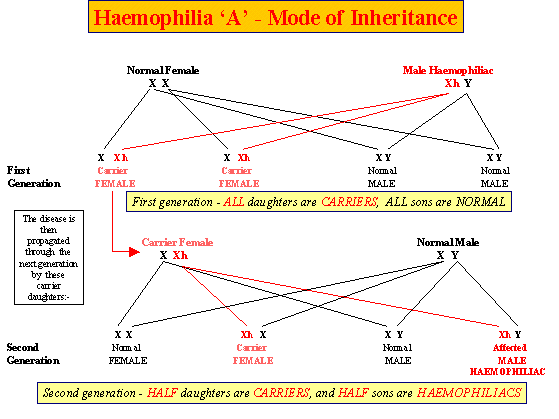Haemophilia 'A' Testing
Haemophilia 'A' is a bleeding disorder. Clinically, it is exactly the same in the GSD as it is in humans. The disease has been known to man as an inheritable problem since the 2nd century! An interesting statement is made in the Babylonian Talmud of that time:- "…when in the same family two male children have died of bleeding after circumcision, the third child should not be circumcised."
This contains an important message – it is normally only MALES that are afflicted. Whilst it is possible for a female to have the disorder it is EXTREMELY rare. The mode of inheritance is shown below… because the disease is sex-linked then it is only necessary to look at the sex-chromosomes X and Y to understand how it is passed on. It is, in fact, a problem with the ‘female’ X chromosome and in the diagram below, the affected or abnormal gene is represented by Xh. The diagram shows all the possible combinations from the first generation of breeding using a male haemophiliac.

So for a female to be affected, the disease would require TWO abnormal X chromosomes to come together – as mentioned before not a likely event.
However, history has taught the dangers of not testing males before using them at stud to be certain that they do not have this disorder. The problem is that by the time we find out about them from the offspring they produce (and from the diagram above you can see that we will not learn of this until the second generation!), the number of affected males and carrier females can be very large. Consequently, it is easy for the disease to spread quickly with the resulting nightmare of people who have bought puppies for pets having to live with a continual risk of there dog possibly bleeding to death if they have even a minor injury. Some simply bleed to death from nothing more than a bump or knock.
Therefore, in August 1991 in the U.K. , the GSD Breed Council of Great Britain set up it’s own Haemophilia ‘A’ screening programme. It was largely due to the furore at that time surrounding a male GSD which had been imported from Germany and was a popular stud. Unfortunately he had sired around 80 litters of puppies before it was discovered that he was a Haemophiliac! We never want to see anything like this again. The scheme was designed and set up by John Allinson – a GSD breeder – who also just happens to have spent over 20 years in a career within analytical pathology.
The test are performed by
Idexx Laboratories. All tests are fully controlled and logged on to a database which is registered with the Data protection Registrar.
Since that time, it has become the norm amongst reputable GSD breeders to ensure any male they use at stud has been tested and proven clear of the disease. The Breed Council scheme is easy to use and inexpensive. The test is performed on a small blood sample collected by your vet. The Breed Council provides a specimen collection and postal kit together with a registration form to be sent with the blood sample. This ensures that regulations are adhered to for sending blood specimens through the post. Full and simple to follow instructions come with each kit.
It is also useful for breeders to test any male puppies they produce since the disease can be picked up at an early age. Typically, as soon as the puppies are big enough to obtain a sample (6 to 8 weeks old) a test can be performed. Also, and importantly, it is not possible to test females for carrier status as the tests do not discriminate them from normal unaffected females. However, testing their sons actually also tests the mothers since half the male offspring of a carrier female will be haemophiliacs. Therefore, we can identify them very early.
Pedigree positions (shaded areas) where known Hemophiliacs can pass the disease on to the dog to which the pedigree belongs.

Males - only the BOTTOM half of this pedigree applies
Females - ALL the pedigree applies
Once a test is performed and is normal, it lasts for life! Breeders can also pass on proof of testing to new puppy owners.
Since the scheme started, previously unknown haemophiliacs and carrier females have been identified in the U.K. We have also found one new case which was a mutation.
The cost of medical procedures change over time, so please confirm charges with your vet.


